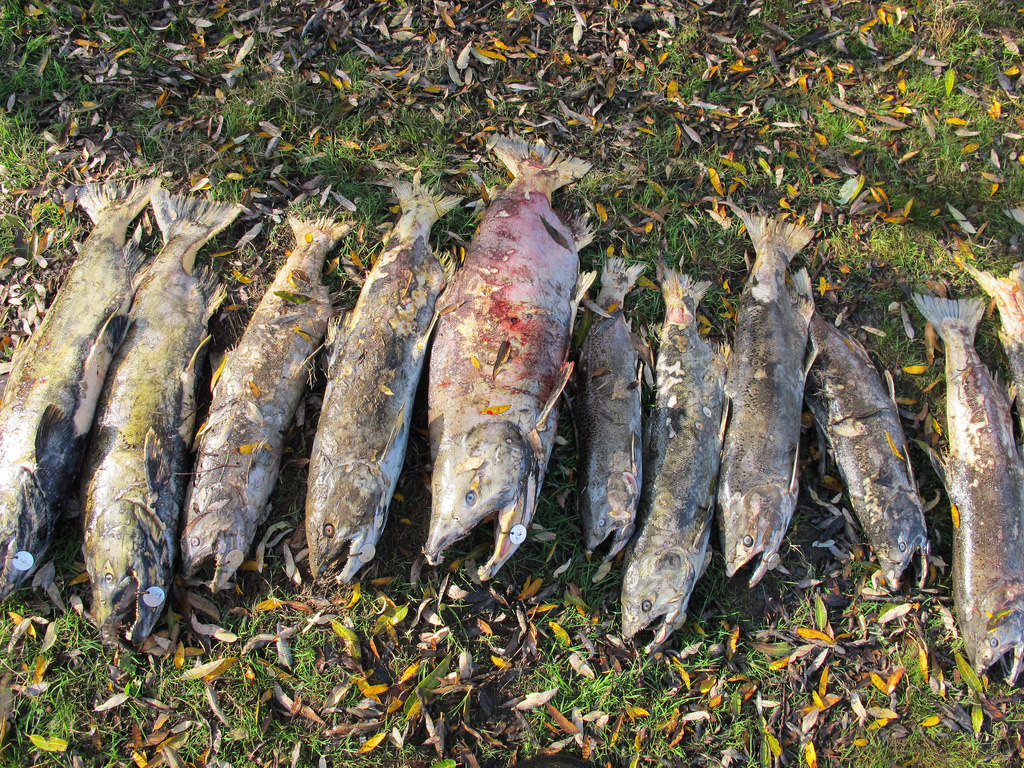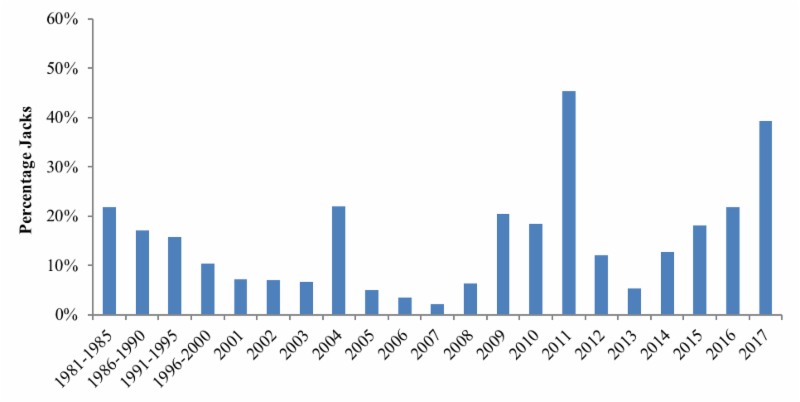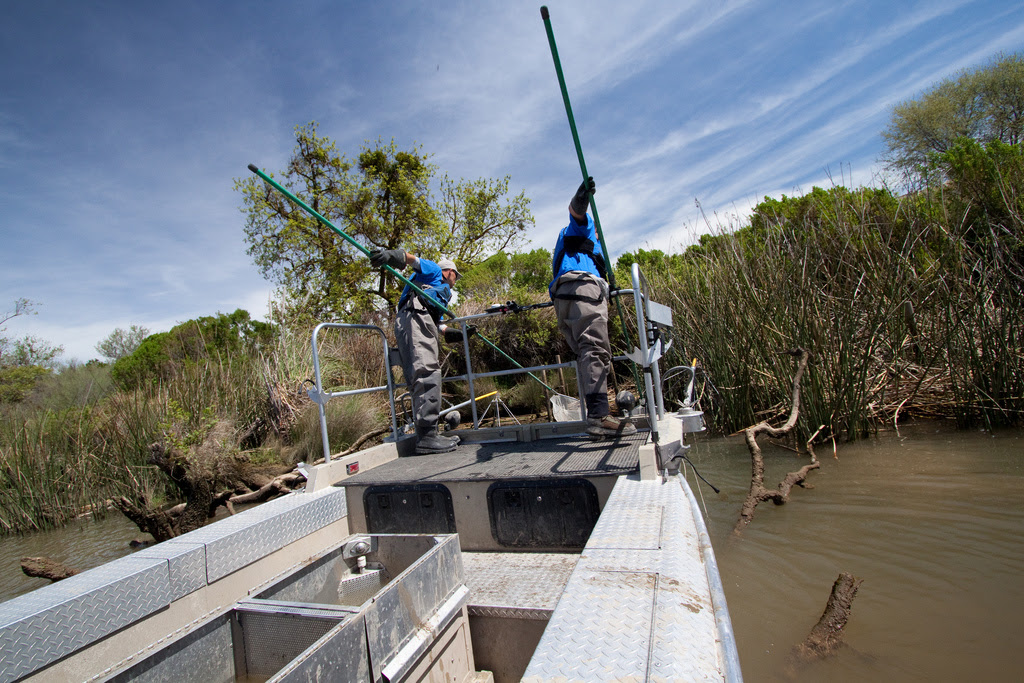Young Salmon on the Rise

by FISHBIO
8-21-2018
Salmon spawning in California’s Central Valley appear to be getting younger. We have previously reported on the prevalence of early-maturing Chinook salmon males, which are called jacks. We have observed jacks attempting to mate with larger adult females during field surveys, and have pondered their life history patterns (see “Hedging Your Bets” and “Jumping Jack“). The number of jacks returning to freshwater in a given year is used to forecast the number of adult Chinook that should return the following year, and we’ve discussed how difficult this process of prediction can be. We have even discussed new research that shows the high frequency of extremely early maturing males among hatchery Chinook in the Columbia River basin, and the increasing rarity of older, larger Chinook salmon across most of the species’ North American distribution. In recent years, the number of jacks returning to the Central Valley, as a percentage of total escapement, has been increasing, with a near-record high observed in 2017. This trend is concerning for several reasons, including the potential for reduced overall reproductive success of fall-run Chinook salmon, and increasing difficulty in forecasting salmon abundance (and harvest) for upcoming fishing seasons. Since age-at-maturity is an inherited trait passed from parents to offspring, the increase in younger males may have long-lasting implications for the Central Valley Chinook salmon fishery.
Chinook salmon reach spawning maturity at different ages. In Central Valley rivers, returning salmon range in age from 1 to 5 years, with 3- and 4-year-old adults being the most common. In a given year, a portion of the returning salmon will also be 2-year-olds, termed “grilse,” that have only spent one year in the ocean before maturing. In many rivers, the age composition of spawning salmon can vary substantially from year to year due to a variety of factors that are difficult to tease apart. Salmon face a tradeoff, in which the chances of surviving and successfully reproducing decrease with age, but reproductive output can increase with age (e.g., bigger, older females can have more eggs; Berejikian et al. 2010). Thus, diverse age composition can be considered a bet-hedging approach to reproductive success and population persistence – if something happens to all returning salmon of a certain age, the returning fish that are a year older or a year younger can ensure population persistence. In the Central Valley, an increase in jacks over a period of several decades is likely due to the cumulative impact of several factors, including the reliance on hatcheries (Hankin et al. 2009) and impacts from ocean fisheries harvesting large fish (Ricker 1980).

Figure 1. The percentage of jacks that have returned to the Central Valley since 1981 (as a percentage of total escapement). Source: PFMC 2018.
The percentage of jacks that returned to the Central Valley in 2017 was the second highest on record since 1981 (Figure 1). Jacks made up 39 percent of the total escapement to the Central Valley, with an estimated 39,867 jacks returning compared to 61,346 adult fall-run Chinook salmon aged 3-5 years (PFMC 2018). Jacks comprised approximately 35 percent of the total fall-run Chinook escapement in the Sacramento River Basin, and approximately 48 percent of the total escapement in the San Joaquin Basin. Since 1981, jacks have made up an average of 15 percent of total escapement to the Central Valley, but this percentage has been consistently higher since 2009. When these values are examined separately for hatchery and natural-area returns, the hatchery returns always have a higher percentage of jacks (Table 1), which supports the hypothesis that hatchery operations are influencing the percentage of jacks in the Central Valley.
Table 1. Percentage of total escapement made up by jacks. Source: PFMC 2018.

Jack escapement is especially important for the Sacramento River basin and the California salmon fishery as a whole because the number of jacks that return to the basin each year is used to predict the escapement for the following year. However, in the last several years, the relationship between the number of jacks and the adult population estimate for the following year has shifted. The return of so many jacks has led to over-estimates in pre-season forecasts for 12 of the 15 years since 2003. Since harvest quotas are based on these forecasts (and no adjustments are made to the quotas during the fishing season), overestimating the number of adult returning salmon can lead to elevated harvest rates and fewer fish “escaping” the fishery to return to rivers, similar to what happened in 2017. Another concern with an increasing abundance of jacks in the Central Valley is that younger salmon have lower reproductive success and contribute fewer individuals to the next generation than older salmon (Berejikian et al. 2010). As a result, the reproductive success of the entire fall-run Chinook salmon population may be reduced as jacks become a more common sight in the Central Valley.
FISHBIO is a dedicated group of research scientists, engineers, and technicians that specialize in counting, tracking, and analyzing trends in fish and wildlife populations throughout the world. An expert staff, technical capacity, and state-of-the-art equipment make FISHBIO a trailblazer in aquatic research. For more information, please visit FISHBIO.com
< Previous Report Next Report >
More Reports

8-13-2018
It’s no secret that most of California’s waterways have been extensively modified to safeguard valuable agricultural lands, public infrastructure, and...... Read More

7-31-2018
They’ve spread across the globe wreaking havoc through the destruction of levees, drainages, and thousands of acres of marshland. It...... Read More

